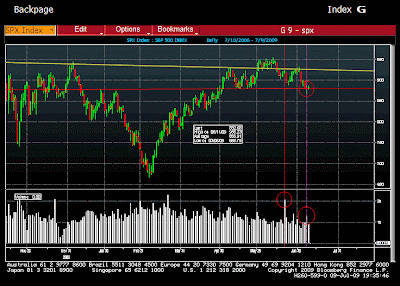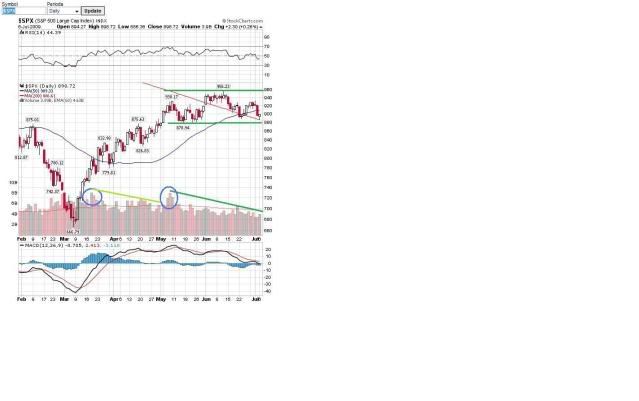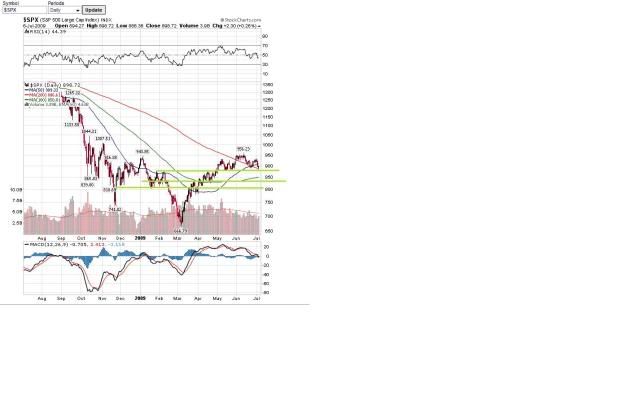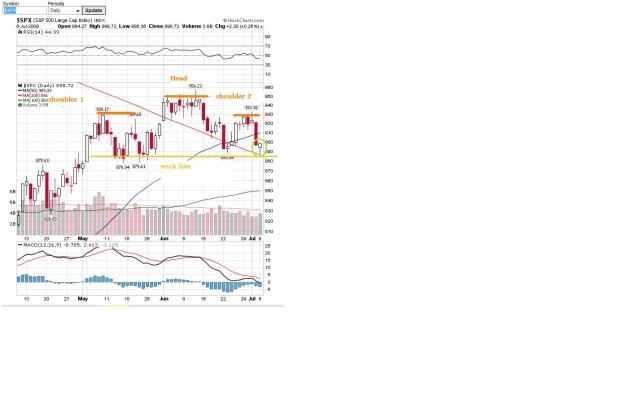Unfortunately due to logistical and technical issues Group ANLZ could not meet this week. Though I will blog on some big developments that happened this past week and update you on my forex positions and new trend developments.
Review of Last week:S&P500:
I'm Proud to say our calls on the Financial Sector were all correct, I cite last weeks statement:
"Overall, we expect financial equities to be above or inline with analyst estimates with the exception of C."
Though we were slightly more bearish on BAC and JPM they posted surprises, and GS blew earnings away before and after its release. C of course had lots of bearish news coming from it. Overall the GS news fueled a good portion of the nearly 7% jump we saw in the S&P500 last week (a 61 basis point move vs 14 average true range (ATR)).
Our call on Google was actually correct as well, they cited trouble from having trouble from ad sales but overall beat estimates.
JNJ was the same as they also surprised on earnings.
YUM definitely was also a good call as they also surprised earnings.
NOK however is a different story. Apparently the market feels different than we do. We were correct in that market shares were relatively unchanged, though markets felt that blackberry and iphone were more of a threat than we perceived. Despite surprise earnings this news still loomed in the back ground.
Overall our individual calls in equities were quite decent. We were correct in support holding at 758-877, and we were correct on the initial move up. However we called for a price target of 880+ by the end of the week. We were wrong and markets actually ended up much more significantly higher ending at 940 at the end of the week.
--------------------------------------
Some Equity Earnings Perfomance Reviews from last week on Financials (Updated July 21, 2009)The Beast on the Street By: Patrick Ambrus
July 21, 2009
Goldman Sachs
On Wednesday July 15th Goldman Sachs Group Inc. reported second Quarter earnings. Once again they did not disappoint. Overall Net Income was $3.44B on $13.76 of Net Income. EPS came in at $4.93/share which is up 23.87% (from $3.98) on q quarterly comparison and up 7.6% year over year (from $4.58-q2-2008). The Strength of revenues hails from fixed income, commodities, and currencies trading. Trading in these securities accounted for $6.8B in revenues alone. Also, equity trading generated $3.18B in revenues. Additionally, revenues were strong in the investment banking division Debt Capital Markets Group: $736M. However, Financial Advisory in Mergers and Acquisitions only produced $368M of revenues down 54% year over year. Diluted EPS came in at $5.71/share excluding a one time preferred dividend payout of $426M related to the Tarp. Another plus came as investors received a 23% return on Equity in the second quarter and 18.3% for the first six months.
Other Additional Highlights include Goldman's repayment of the $10B Tarp funds last month. This means that Goldman will still be regulated as a bank holding company by the federal reserve, but the group has the freedom to run its business as it sees fit; especially when it comes to pay. Of the $13.76B in revenues, Goldman Sachs used 49% to put in the year end bonus pool. In total $11.4B has already been earmarked for bonuses. If the record breaking trading profits are maintained in the second half of the fiscal year then each of the 29,400 employees on average could earn $770,000. Take that Capital Hill.
Even though many positive revenue streams exaggerate the euphoria of Q2, there are still underlying issues on Goldman's balance sheet. The firm still maintains $8B worth of exposure to commercial real estate; of which $1.6B in the deadly Mortgage Backed Securities. Additionally, the other $6.4B remain on the books at a value just over half of Book Value. When CFO David Vinair was asked if he expects earning growth to continue he said, "We're in a volatile business."
My Outlook on Goldman Sachs for the second half is Positive. The Group is first in Financial Advisory of Global M&A according to Thomson Reuters. I expect global Mergers and Acquisitions to pick up in the second half as corporations look to buy on cheap valuations. Also, the firm's liquidity rose 4.2% to $171B in the second quarter. This reassures investors of Goldman's stability if the economy were to further decline. Additionally, David Vinair when asked about the firm's Security Services business explained, "Money is starting to flow into hedge funds." Expect this business to increase profits in quarter 3. Not to mention, Goldman paid a $0.35/share dividend to common holders. Undoubtedly, the most important information to consider is Goldman's competition. Last year at this time the firm had 3 more major competitors; Bear Stearns, Leheman Brothers, and Merrill Lynch all of whom no longer exist independently. Less competition means more Profits for The Goldman Sachs Group.
Price Target: $175-180.
Highlights from Citigroup, Bank of America, and J.P. Morgan Chase:
Citi
Revenues- $30B
Net Income- $4.3B
CitiCorp- $3.1B
CitiHoldings- $1.4B
Diluted EPS- $0.49/share
Tier One Capital Ratio- 12.7%
-Results include an $11.1 billion pre-tax ($6.7 billion after-tax) gain associated with the Morgan Stanley Smith Barney joint venture transaction, which closed on June 1, 2009
-Total deposits were $805 billion, up 6% sequentially, and flat with prior year levels
-Headcount declined by approximately 30,000 from the first quarter of 2009, to 279,000
-Credit costs increased to $12.4 billion, including an addition of $3.9 billion to loan loss reserves, bringing the total allowance for loan losses to 5.6% of total loans
B of A
Revenues- $32.774B
Net Income- $3.2B
Diluted EPS- $0.33/share (deducting preferred dividents to U.S. Gov. and other preferred holders)
Tier One Capital Ratio- 11.93%
- Bank of America Merrill Lynch ranked No. 1 in high-yield debt and leveraged loans based on volume
-Average retail deposits in the quarter increased $136.3 billion, or 26percent, from a year earlier, including $104.3 billion in balances from Merrill Lynch and Countrywide
-The provision for credit losses was $13.4 billion, flat with the first quarter
-Nonperforming assets were $31.0 billion compared with $25.6 billion at March 31, 2009
J.P. Morgan
Revenues- $27.7B (record)
Net Income- $2.7B
EPS- $0.28/share
Tier 1 Capital Ratio- 9.7%
-Repaid in full the $25 billion TARP preferred capital
-Extended approximately $150 billion in new credit to consumers, corporations, small businesses, municipalities, and non-profits
-Reported record Investment Banking Fees and Fixed Income Markets revenue in the Investment Bank; $7.3B revenue and $1.5B net income
-Return on Equity was 18% on $33.0 billion of average allocated capital
-------------------------
OIL (from previous week):
Congrats to Kell who made the call on oil at 65 towards the end of the week. Oil it highs of 64.83 by Friday, though pulled back temporary during the weekend. More importantly the groups call of resistance of 55-60 held as prices bounced off 60 trading early Monday.
------
This weeks S&P500 Earnings:Oil:
• Cabot Oil & Gas
• Diamond offshore drilling
• Halliburton
• BJ services
Airline:
• Southwest airlines
• Boeing
International Presence:
• Coca cola
• Caterpillar
• Starbucks
• MacDonald
• Kimberly Clark
• 3m
Financial:
• Wells Fargo
• Morgan Stanley
• American Express
• E*TRADE
There are A LOT more in tech and other sectors though we will focus on these. Unfortunately I will not go into individual charts and fundamental analysis since I am limited on time.
Oil Equities:
For oil equities, I don't follow as closely as my associate Pat, who looks at actual supply and demand numbers. Though I will point out that consumer demand is still weak, exports around the world are weaker, I'm sure corporate demand for oil has weakened, and there is relative weakness in oil prices (from around mid 70's from a few weeks earlier). Since the drop in oil prices has been more recent its possible it may not be reflected in earnings, though there should be no outstanding performances in my opinion (I making this call based off top down analysis, no fundamental or technicals involved).
Airline:
I expect to have inline to a negative surprise in earnings with less consumer demand for travel and increases in savings.
Financial Sector:
We may see similar trends in the Financial sector though, we may see weakness from AE, E*trade, and maybe Wells Fargo.
International:
The international stocks may be an interesting story, as some of them may be mixed.
---------
I will not be making any specific calls for equities since I have done no in depth analysis in each sector.
The S&P500 This Week:
Technical View:
Support/Resistance:
The S&P500 is currently trading in a bullish environment as prices moved 1% + higher. The very important level of "950" was breached today as prices closed at 951, however I am still waiting for a very solid close above 951 to be even more bullish. Its possible if we get a break in 950 resistance we will see 970+ by the end of the week.
RSI:
However on the whole the RSI is telling me the S&P500 will need to make a new higher low in order to sustain such rapid upward moves. What does this mean?
BUY ON THE DIP. A long as prices remain above the previous higher low, you should be buying above that level (ie buy above 877 at this point in time).
MACD:
The MACD is given full out support of a bullish move up as the short average has crossed above the longer term average.
Volume:
Arguably you are getting quite a bit of bullish volume based off the Bloomberg charts.
Patterns Analysis:
It is possible the bullish continuation patterns I cited last week (flag/pennant and rectangular continuation) may have been true even though lack of concurrent volume confirmation. It is possible volume confirmation was given way back in early march when the bear market rally ensued (that is if we can even call it a bear market rally anymore).
It would also seem that the bearish head and should pattern I cited was not as strong and apparent for the bearish argument. It would be well worth studying why this is the case for future head and shoulder pattern formation developments (study to see if a new head and shoulder formation is legitimate or not). its perhaps I drew my pattern formation wrong, but this I will need to look into deeper.
For equities, I maintain a short term bullish stance. As the 200 SMA approaches convergence under the 100 SMA I am becoming more and more bullish mid term out. If the 200 SMA stays under the 100 SMA with strong bullish indicators I will have to re-evaluate my long term bearish stance. Though for now I remain bullish with mixed to inline earnings, and short term bullish formations.
-----------
OIL:
Technical View:
I am bullish on oil technically to 70+ over the next two weeks.
I cite:
50, 100, and 200 SMA formation bollinger band expansion to the upper deviations bullish volume confirmation On the downside though, its possible prices will hit resistance around the 70 levels.
Fundamentally it would be nice to see numbers supporting such a move however, I have not looked into this side yet.
--------------
CURRENCIES - Spot FOREX

I'm glad to show that I'm finally making positive profits on my forex positions. I corrected my AUD position and it still had room to the upside which I am currently still profiting from. I thought I had entered short on the USD/CAD which would have made sense considering correlations to the pairs I'm trading along with my overall dollar thesis (currently bear on the dollar vs most the major pairs).
Luckily I got some charts today, so I will make some brief comments. I will start the EUR/USD which is worrying me right now:
EUR/USD:
Currently the price is scratching along and slightly above the upper 2nd standard deviation bollinger band (SD BB). Some back testing shows that prices won't necessarily re-visit the lower bollinger bands, and the MACD if it continues the way it is at, certainly would confirm continued dollar weakness. Though considering that prices are coming to a squeeze it is certainly making me nervous. If I were truly trading this market, I would have a tight stop to secure my profits.
The RSI may show that prices may dip to the mid bands and continue upward.
I will maintain my position for now...
GBP/USD:
I'm a bit more bullish on the Pound as prices have pierced lower bands and have room to move to the upper bands. RSI confirms further movement north and the MACD is also favorable for the bulls.
Currently prices are coming to a squeeze, I feel that prices will break resistance levels at 165-166, which may force prices actually to pierce upper BB bands and cause a temporary retracement before continuing a bullish trend up.
AUD/USD:
AUD is similar to the pound in a technical sense, though maybe moving of very different fundamentals considering its geographic location in the Pacific Asia. Though on a whole Asian markets are very correlated to US markets and so we are overall seeing strong correlations amongst major pairs.
It has room to move upward, but may pierce upper deviations, again the MACD is favorable for bulls and the RSI needs a retracement before any continued move up. Which means the Aussie will need to break resistance at .80's.
CAD/USD:
The looney is a more interesting chart. We will probably see a bounce off support levels off 1.105 which means temporary dollar strength. This will happen before the support levels are retested. Certainly the MACD says support levels will be broken. It will be interesting to see how this pair plays out, though I am not trading it currently.
I will continue to opt out of this pair as it seems a bit questionable as to whether it is reacting of oil fundamentals vs. economic fundamentals or some sentiment driven event such as risk aversion.
------
I will end by citing Bullish Evidence for the financial markets form a fixed income perspective.
Stacking the 2 year vs 10 UST:

Short term yields are diverging from long term yields. The trend has been continuing this way for the past few weeks. This is pretty bullish evidence for any of you green shooters out there...
To be honest, the markets and economies have lots of crap out there in my opinion, but its hard to ignore all this bullish evidence...
-Alexander Lê of Group ANLZ

























